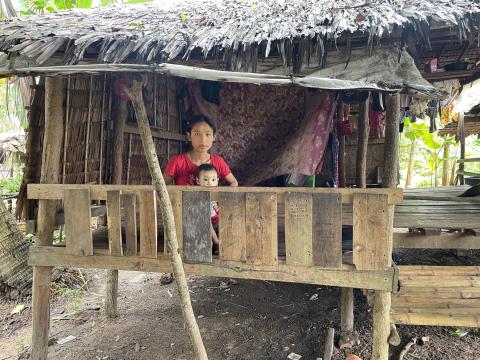Leaving misery behind

In the small village of Ayeyarwaddy Region's Thabaung Township, a 23-year-old young woman named Khing, finds that her role of being a competent mother is increasingly challenging. Her sweet home is shared with her husband and their two young children, both under the age of 5. Their whole family relies solely on her husband's income and job, which is undependable at times and irregular in their everyday lives. This uncertain financial situation pushes the family to the edge as they strive to ensure their children's survival and well-being.
She faces a significant obstacle in providing her two little ones with adequate nutrition. Hence, the family's financial constraints and lack of knowledge about Infant and Young Child Feeding make it difficult for her to provide qualified complementary feeding for her children.
However, a glimmer of hope arrives in the form of nutrition promotion activities by World Vision Myanmar (WVM) and UNICEF in her village. These organisations are occupied with implementing nutrition activities in the Ayeyarwaddy Region, specifically targeting children under 5, and pregnant and lactating women. It is such a blessing that Khing's village is included in the Nourish Delta II project.
In April 2023, a simplified version of child malnutrition registration was carried out in the Thabaung Area. Khing's youngest child, 14-month-old Thazin, was identified as moderately acutely malnourished based on her Mid-Upper Arm Circumference (MUAC) measurement of 122 mm. As part of the supplementary feeding programme (SFP), Thazin was given ready-to-use therapeutic food (RUTF) in the form of one sachet per day. Additionally, a volunteer from their village assisted in providing albendazole and vitamin A from the sub-Rural Health Center after a month. The support didn't just end there and WVM staff conducted an Infant and Young Child Feeding (IYCF) counseling session for the child's mother, Khing. During the counselling session, Khing realised how to prepare healthy and nutrient-complementary feeding for her child without incurring high costs. She also learned about the advantages of using RUTF and the importance of consistent and proper complementary feeding, represented by the four stars in the IYCF flip chart.
To ensure the child's progress and improvement, the village volunteer was tasked with monitoring Thazin's nutritional status and overall health conditions on a biweekly basis. Thanks to the diligent adherence to the recommendations and support provided by WVM & UNICEF, the child showed gradual improvement over a month in the SFP. Besides, her body weight increased to 7.9 kg, and her MUAC measurement improved to 130 mm, leading to her discharge from the SFP.
Khing now fully understands the significance of complementary feeding for children under 5 and the potential for rapid recovery from acute malnutrition. As a result, she became actively involved in nutrition education sessions, monthly MUAC screenings, and IYCF counselling sessions. Her newfound knowledge and dedication to her child's health are excellent now in courtesy of the invaluable support and nutritional knowledge provided by World Vision International during the treatment of her child's moderate acute malnutrition.